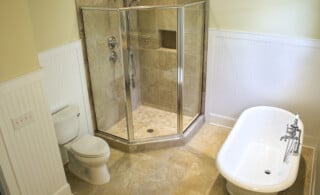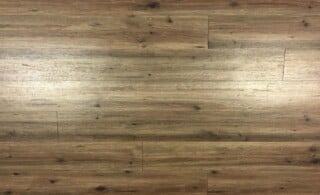
On This Page:
- Types of Flooring
- DIY Considerations
- More Signs of Floor Problems
- After the Repairs
- Consider Hiring a Pro
When you step into your bathroom, there are few things as disheartening as feeling the floor sag beneath your feet. Likewise, you don’t want to see tiles buckling or your toilet leaning because of a rotten subfloor. If you see any of these signs, it’s time for action.
Types of Flooring
The level of difficulty in repairing a bathroom floor varies considerably depending on the type of flooring you have and the extent of the damage. The average cost to repair flooring is between $350 and $1,200, but here are how the prices vary based on material:
Vinyl Flooring
Avg. cost to repair: $390
In some cases, the damage may be largely superficial and easily repaired. For instance, if you have a vinyl or linoleum flooring, you may be able to remove the flooring and replace it with new boards. You need to be aware of the design and appearance though, as to avoid a floor that looks mismatched. Some other types of damage you will have to address are:
- Cuts and abrasions – You can fix these by replacing the pieces that are affected with new ones.
- Wear and tear – Over time, your vinyl flooring will lose its sheen and new appearance as you continue to use the bathroom. To make it look renewed you can add felt protectors or a finish to protect it.
- Burns – Vinyl is susceptible to burn damage, whether from a hot iron or other personal appliances you keep in the bathroom. You will have to patch the spot that’s burn or replace that section entirely.
- Buckling – Vinyl wood flooring, just like normal flooring, can start to buckle. You will need to add more adhesive to keep it in place or cut out sections that mesh with one another too much to cause the buckling.
Tile Flooring
Avg. cost to repair natural stone tile: $610
Avg. cost to repair ceramic tile: $420
If you have damaged tile, repairs can be simple or problematic depending on the issue. Some of the common ones you’ll see with ceramic and natural stone tiles are:
- Stains
- Cracks or chipping
- Loose tiles
- Scratches
- Broken tiles
To address stains and scratches, you can use natural cleaning products designed for tile or use a polish to fix the blemish. For cracks, loose tiles and broken ones, you’ll usually to remove the problem tile and replace it with a new one. Make sure they match though, or else you’ll have a tile that stands out in your bathroom. You should always keep extra tiles on hand for this reason.
Wood Flooring
Hardwood flooring is a natural, somewhat living substance. This means you could run into a wide variety of problems, given the moisture in the bathroom. Some repairs to face with wood flooring include:
- Scratches
- Buckling, cupping or shelling
- Gaps between the boards
- Mold
The imperative part about maintaining a wood floor in the bathroom is to get rid of excess moisture. This is usually solved with a bathroom exhaust fan, which you can install cheaply. Buckling, cupping, shelling, gaps, mold — all of this is caused by excess moisture. So if you do see any of these problems, you will need to replace the boards. In the case of mold, this usually involves hiring a remediation service.
Scratches are slightly simpler to address with hardwood flooring. You can use a sander to get rid of the problem (don’t sand too much, though!). Then you can apply a new stain or finish to protect the floor. Putting down rugs is also a way to keep the wood floor protected.
DIY Considerations
Here are some things to consider when you are contemplating a DIY bathroom floor repair:
1) You must assess whether the problem is cosmetic or structural.
Cosmetic problems are fairly easy to fix. For instance, if a water leak has caused discoloration to your vinyl flooring, it’s possible to strip away the old vinyl covering and replace the damaged flooring with new vinyl.
Structural problems are more labor intensive and costly. If water has caused significant damage to the structural integrity of your floor, you’re looking at an extensive repair that includes removing all of the damaged flooring, repairing or replacing the subfloor beneath it and reinstalling the floor entirely.
2) You must address the problem that led to the floor damage.
In many cases, a damaged bathroom floor is the result of plumbing issues. Not all plumbing problems are readily apparent to the untrained eye. Sometimes evidence of water damage will appear some distance from the actual leak itself.
Therefore, before embarking on a floor repair, it’s important to address the leak at its source. In many cases, the most cost-effective way to do this is to hire a professional.
3) You must understand the extent of the repair work needed.
If you find that your subfloor is damaged beyond repair, you will likely have to remove everything in the problem area. If removal is required, the difficulty of the repair ramps up considerably, making it likely that you will need the help of a pro.
If your subfloor does not need replacing, you might still consider how you will dry the subfloor completely to prevent mold. In many cases, specialized equipment is needed to dry the floor to stop the growth of mold and mildew.
4) You must consider your skill level and the time you have to do the project.
When considering whether to take on a bathroom floor repair as a project, you must take into account your level of skill as a handyman and the time you have to complete your project.
Some skills you will need are:
- General carpentry
- Laying tile or other floor coverings
- Plumbing
- Demolition (if needed)
More Signs of Floor Troubles
For the sharp-eyed homeowner, there are some signs that a bathroom floor needs repair long before it sags beneath your feet. For instance, if your floor covering is vinyl or linoleum, you may observe a stain developing for no obvious reason. If your have carpeted floors, you may feel unusual dampness around the impacted area. Wood floors will likely show signs of warping or buckling.
If have tiled flooring, you may notice that the individual tiles are beginning to loosen. Additionally, the grout lines between your tiles might become discolored.
If your bathroom is on the second floor of your home, you might also notice a stain on the ceiling downstairs. In more advanced cases, the ceiling may begin to sag. All of these signs can occur long before your floor begins to feel spongy or soft from water damage.
After the Floor Repair
Once you’ve finished your repairs, replace your fixtures and molding to finalize your repairs. Additionally, you must dispose of all damaged materials in an appropriate manner.
Consider a Pro
If bathroom floor repair seems overwhelming, there’s no need to worry. A professional can help you repair your floor with minimum disturbance to your daily routine. The pro you hire will be able to handle everything from damage assessment to post-job clean-up. Working with a pro will save you time, money and stress.
 Is It Possible to Level a Bathroom Floor?
Is It Possible to Level a Bathroom Floor?  Laminate Flooring vs. Hardwood: What’s the Difference?
Laminate Flooring vs. Hardwood: What’s the Difference?  Laminate Floor vs. Vinyl: Which Is Better for Your Home?
Laminate Floor vs. Vinyl: Which Is Better for Your Home?  Engineered Wood Floors vs. Laminate Floors: What’s the Difference?
Engineered Wood Floors vs. Laminate Floors: What’s the Difference?  Best Bathroom Flooring
Best Bathroom Flooring 

Are You Familiar With This Topic? Share Your Experience.